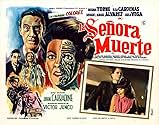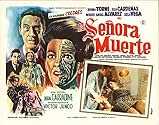Aggiungi una trama nella tua linguaA mad scientist teams with an evil, disfigured woman to kidnap and operate on young women to make her look beautiful again.A mad scientist teams with an evil, disfigured woman to kidnap and operate on young women to make her look beautiful again.A mad scientist teams with an evil, disfigured woman to kidnap and operate on young women to make her look beautiful again.
- Regia
- Sceneggiatura
- Star
Foto
Fernando Osés
- Lt. Henry
- (non citato nei titoli originali)
Marcelo Villamil
- Man at fashion show
- (non citato nei titoli originali)
Trama
Recensione in evidenza
In 1968, legendary horror icons John Carradine and Basil Rathbone traveled to Mexico to film "Autopsia De Un Fantasma", a low-budget horror movie that went to become a Cult film due to its cast. By strange reasons (some state that Carradine's career was experiencing a dry spell at the time), Carradine stayed after that and made four low-budget horror films for producer Luis Enrique Vergara. In Filmica Vergara Productions, Carradine would face Mexican wrestler Mil Máscaras in "Pacto Diabólico" ("Diabolical Pact") and "Enigma De Muerte" ("Secret of Death"), as well as playing the old Count Dracula one more time in "Las Vampiras" ("The Vampire Girls"), but the best of the four films would be the last one, an odd slasher with sci-fi undertones named "La Señora Muerte" ("Mrs. Death").
"La Señora Muerte" is the story of Marlene (Regina Torné), a successful fashion designer who is deeply in love with his husband, Dr. Andrés (Victor Junco) and has a life of happiness. However, this soon comes to a sudden end when Andrés has a fatal heart attack due to Cancer. Before collapsing, Andrés asks Marlene to take him to Dr. Favel (John Carradine), as he will be the only one able to help her. In Dr. Favel's lair, the strange scientist attempts to bring back Andrés using Marlene's blood in a radioactive experiment that tragically fails, making Marlene's body "unstable" due to radiation (making her go from deformed creature to beautiful woman at moments). Favel thinks he needs larger amounts of women's blood, so now Marlene must kill for blood not only to return to normality, but also to save her husband's life.
At first sight, "La Señora Muerte" looks like a typical horror film about a mad scientist (with flashy machines and a hunchbacked assistant), however, after Marlene becomes mutated, the film leaves Dr. Favel and becomes a really original slasher were the focus is not on the victims, but on the killer herself. We really can see the progression of this female serial killer, as her first killings are exact and effective, but as guilt begins to corrode her, her spirit begins to crumble. Written by Ramón Obón, the film is a nice surprise, as the sudden change of tone (from sci-fi to slasher) is actually beneficial, and really sets the film apart from other examples of Mexican horror (it even feels as if it was written by two very different writers).
As the last film of Jaime Salvador (experienced Mexican director who started with the excellent "El Jorobado" back in 1943), the film could be seen as yet another example of the bad state of Mexican industry after the end of the "Golden Age of Mexican Cinema". While "La Señora Muerte" is not really a bad film, Salvador's execution of the script is very anachronistic at times (the scenes with John Carradine seem to be taken out of a 50s film and forced into the movie), although to his credit, some of the scenes of the "slasher part" of the film are very well crafted, in an almost Giallo style.
While John Carradine's presence is surprising, and gives the film the feeling of a rarity, his performance is kind of regular, and although somewhat effective, at times he feels definitely out of place (the bad way the script is structured in his scenes doesn't really help him). Still, he manages to be haunting at times, despite what he had to work with (and the awful Spanish dubbing his character suffers). Quite and opposite image is Regina Torné as Marlene, who really transmits the pain and the suffering of someone who is forced to kill to survive, almost like a modern vampire. The rest of the cast is pretty average and simply are there to do the job.
The main problem of "La Señora Muerte" is neither the low-budget nor Salvador's anachronistic direction, the real problem is that the movie feels as two very different films mixed together. What could had been an excellent Giallo style slasher suffers the inclusion of themes and motives of a 50s mad scientist tale, and the contrast between them is huge. While the "slasher part" is dark, creepy and almost elegant, the "mad scientist part" has bright colors, bad special effects and hammy acting; and is this sharp contrast between them what in the end almost kills the film, as it feels as if the mad scientist story arc was included just to get Carradine in the movie.
"La Señora Muerte" is an oddity not only because of the inclusion of John Carradine in the cast, but also because of the strange way the film is crafted, as well as the inventive slasher story arc it has. While it would be easy to discard it as another 60s bad horror (as the first scenes seem to point out), it becomes into a different kind of beast past the wacky intro. A lost obscure gem that deserves at least more recognition. 6/10
"La Señora Muerte" is the story of Marlene (Regina Torné), a successful fashion designer who is deeply in love with his husband, Dr. Andrés (Victor Junco) and has a life of happiness. However, this soon comes to a sudden end when Andrés has a fatal heart attack due to Cancer. Before collapsing, Andrés asks Marlene to take him to Dr. Favel (John Carradine), as he will be the only one able to help her. In Dr. Favel's lair, the strange scientist attempts to bring back Andrés using Marlene's blood in a radioactive experiment that tragically fails, making Marlene's body "unstable" due to radiation (making her go from deformed creature to beautiful woman at moments). Favel thinks he needs larger amounts of women's blood, so now Marlene must kill for blood not only to return to normality, but also to save her husband's life.
At first sight, "La Señora Muerte" looks like a typical horror film about a mad scientist (with flashy machines and a hunchbacked assistant), however, after Marlene becomes mutated, the film leaves Dr. Favel and becomes a really original slasher were the focus is not on the victims, but on the killer herself. We really can see the progression of this female serial killer, as her first killings are exact and effective, but as guilt begins to corrode her, her spirit begins to crumble. Written by Ramón Obón, the film is a nice surprise, as the sudden change of tone (from sci-fi to slasher) is actually beneficial, and really sets the film apart from other examples of Mexican horror (it even feels as if it was written by two very different writers).
As the last film of Jaime Salvador (experienced Mexican director who started with the excellent "El Jorobado" back in 1943), the film could be seen as yet another example of the bad state of Mexican industry after the end of the "Golden Age of Mexican Cinema". While "La Señora Muerte" is not really a bad film, Salvador's execution of the script is very anachronistic at times (the scenes with John Carradine seem to be taken out of a 50s film and forced into the movie), although to his credit, some of the scenes of the "slasher part" of the film are very well crafted, in an almost Giallo style.
While John Carradine's presence is surprising, and gives the film the feeling of a rarity, his performance is kind of regular, and although somewhat effective, at times he feels definitely out of place (the bad way the script is structured in his scenes doesn't really help him). Still, he manages to be haunting at times, despite what he had to work with (and the awful Spanish dubbing his character suffers). Quite and opposite image is Regina Torné as Marlene, who really transmits the pain and the suffering of someone who is forced to kill to survive, almost like a modern vampire. The rest of the cast is pretty average and simply are there to do the job.
The main problem of "La Señora Muerte" is neither the low-budget nor Salvador's anachronistic direction, the real problem is that the movie feels as two very different films mixed together. What could had been an excellent Giallo style slasher suffers the inclusion of themes and motives of a 50s mad scientist tale, and the contrast between them is huge. While the "slasher part" is dark, creepy and almost elegant, the "mad scientist part" has bright colors, bad special effects and hammy acting; and is this sharp contrast between them what in the end almost kills the film, as it feels as if the mad scientist story arc was included just to get Carradine in the movie.
"La Señora Muerte" is an oddity not only because of the inclusion of John Carradine in the cast, but also because of the strange way the film is crafted, as well as the inventive slasher story arc it has. While it would be easy to discard it as another 60s bad horror (as the first scenes seem to point out), it becomes into a different kind of beast past the wacky intro. A lost obscure gem that deserves at least more recognition. 6/10
I più visti
Accedi per valutare e creare un elenco di titoli salvati per ottenere consigli personalizzati
Dettagli
- Tempo di esecuzione1 ora 25 minuti
- Mix di suoni
Contribuisci a questa pagina
Suggerisci una modifica o aggiungi i contenuti mancanti

Divario superiore
By what name was La señora Muerte (1969) officially released in Canada in English?
Rispondi









